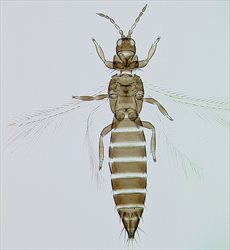
Female
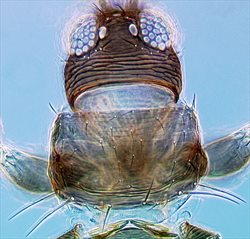
Head & pronotum
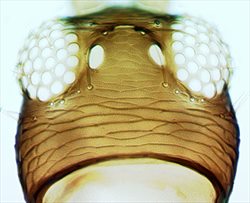
Head

Antenna
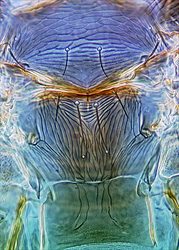
Meso & metanota
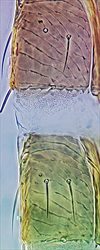
Pleurotergites
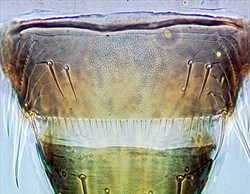
Tergite VIII
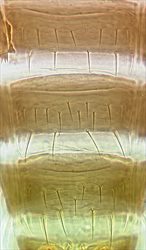
Sternites V-VII

Fore wing

Fore wing
Both sexes fully winged. Body and legs brown, tarsi and antennal segment III yellow; fore wings pale. Antennae 8-segmented; segments III–IV with sense cone forked. Head with cheeks convex, 2 pairs of ocellar setae; pair III arising on anterior margins of, and slightly longer than side of, ocellar triangle; postocular setae pairs I & III shorter than ocellar setae pair III, postocular setae pair II minute. Pronotum with 2 pairs of long posteroangular setae; posterior margin with 3 (or 4) pairs. Metanotum with parallel lines of sculpture converging medially at posterior; median setae arising near anterior margin; campaniform sensilla present. Fore wing first vein with 3 setae on distal half; second vein with complete row of about 14 setae. Abdominal tergite II with 3 lateral marginal setae, V–VIII with paired ctenidia, on VIII posteromesad to spiracles; tergite VIII posteromarginal comb complete, microtrichia long; pleurotergites with 3–4 discal setae. Sternite II with 2 pairs of marginal setae, III–VII with 3 pairs; sternite II with few discal setae, III–VII with 15 to 20 discal setae in irregular double row.
Male smaller than female; tergite VIII without posteromarginal comb; sternites III–VII with broadly transverse pore plate in front of discal setae.
The genus Thrips is the second largest genus in the Thysanoptera, and currently includes, worldwide, over 290 species. All members of genus Thrips lack ocellar setae I on the head, and they all have ctenidia on tergite VIII posteromesad to the spiracles. Other characters, such as number of antennal segments, number of setae on the fore wing veins, and number of discal setae on the sternites are variable between species (Palmer, 1992; Nakahara, 1994; Mound & Masumoto, 2005). Thrips vulgatissimus is one of a small group of species in this genus with discal setae on the pleurotergites as well as the sternites. Although similar to Thrips atratus in structure, vulgatissimus has only three setae on the distal half of the first vein of the fore wing. It is most similar to Thrips meridionalis Priesner, a common pest of stone fruits in parts of the Mediterranean region.
Polyphagous, and feeding and breeding in the flowers of various host plants, but associated particularly with white flowers such as Cerastium tomentosum [Caryophylaceae], and species of Apiaceae and Asteraceae. Adults can be found in large numbers in the flower umbels of roadside verge plants like Anthriscus sylvestris and Heracleum sphondylium.
Common and widespread, found throughout Britain from the Isles of Scilly to the Shetland Islands, as well as across the island of Ireland (Mound et al., 1976; O'Connor, 2008). Widespread across the northern Holarctic from Asia to North America, it has also been introduced to New Zealand (Mound & Walker, 1982; Nakahara, 1994; Mirab-balou et al., 2011).
THRIPIDAE - THRIPINAE
Thrips vulgatissimus Haliday
Thrips vulgatissimus Haliday, 1836: 447
Physopus pallipennis Uzel, 1895: 110
Physopus pallipennis var. adusta Uzel, 1895: 110
Taeniothrips lemanis Treherne, 1924: 87
Taeniothrips vulgatissimus f. gracilis Priesner, 1926: 298
Taeniothrips vulgatissimus f. atricornis Priesner, 1926: 298
Taeniothrips americanus Moulton, 1929: 130
Physothrips gentianae Bagnall, 1933: 653
Taeniothrips tahvanus Hukkinen, 1936: 139
Mirab-balou M, Tong X, Feng J & Chen X (2011) Thrips (Thysanoptera) of China. Check List 7: 720–744.
Mound LA & Masumoto M (2005) The genus Thrips (Thysanoptera, Thripidae) in Australia, New Caledonia and New Zealand. Zootaxa 1020: 1–64.
Mound LA, Morison GD, Pitkin BR & Palmer JM (1976) Thysanoptera. Handbooks for the Identification of British Insects 1 (11): 1–79.
Mound LA & Walker AK (1982) Terebrantia (Insecta: Thysanoptera). Fauna of New Zealand 1: 1–113.
Nakahara S (1994) The genus Thrips Linnaeus (Thysanoptera: Thripidae) of the New World. United States Department of Agriculture. Technical Bulletin 1822: 1–183.
O’Connor JP (2008) A review of the Irish thrips (Thysanoptera). Irish Naturalists’ Journal 29: 20–24.
Palmer JM (1992) Thrips (Thysanoptera) from Pakistan to the Pacific: a review. Bulletin of the British Museum (Natural History) Entomology Series 61 (1): 1–76.